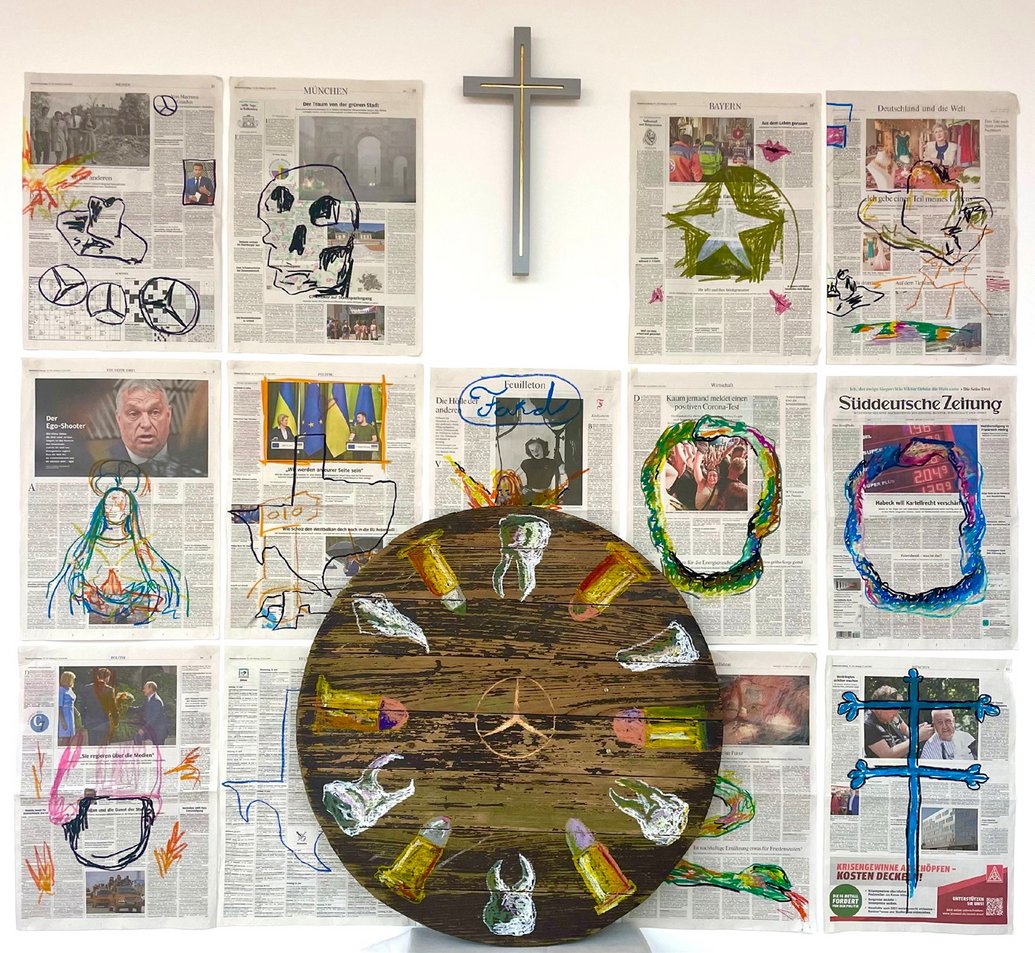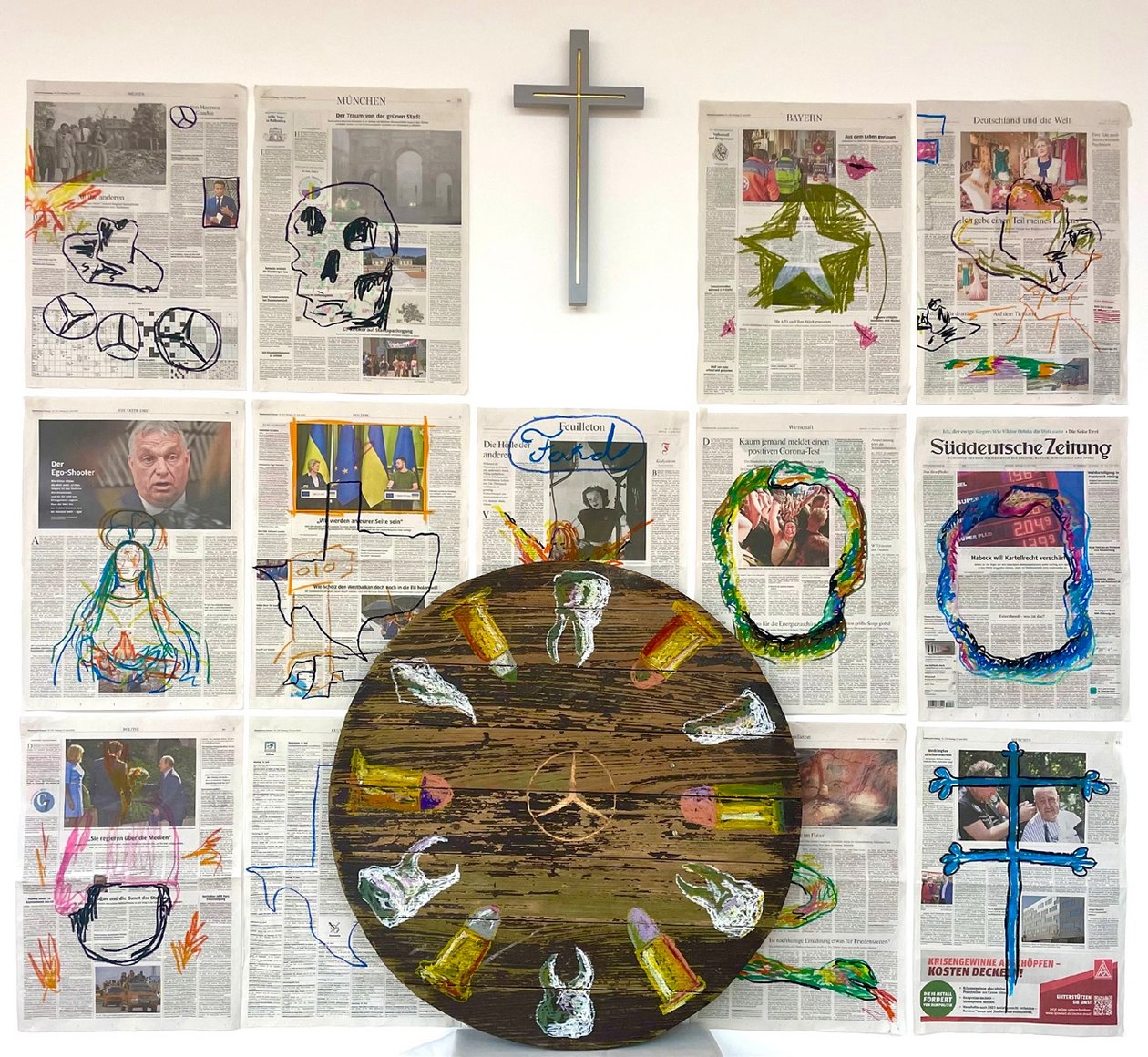Mercedes in War and Peace
Info:
History, war and art exert a great influence on the fate of people. Finley Jacobsen is sure of that. He therefore devotes himself to remembering and forgetting. His work „Mercedes in War and Peace“ serves as an example. Finley Jacobsen says that every remembrance is accompanied by a distortion of the truth, whether intended or not. Similar to the retelling of stories. That‘s why he tries to get to the root with his art. He implicitly raises the question that everyone can ask: How would history have to be told from as truthful an observation as possible? For his artwork, Finley stages a found object from the vicinity of his German workplace: a discarded wooden well cover. It was a chance find: visibly robbed of its function, lying around carelessly, abandoned to successive rotting. Like sometimes aspects of our history. This wooden disc becomes the center of his altarpiece. Finley carves a Mercedes star into the well cover. He frames it with painted teeth and cartridges. They symbolize human sacrifice and gun violence. Painted pages of a German daily newspaper form the altar panels, which open upward to a cross. Simplistic symbolic drawings adorn the current news stories, which include the forward push of the autocracy, the state of our nature, the pandemic, the economic crisis, the war in Ukraine, worldwide protests, but also people in difficult situations. Finley deliberately paints over the information communicated as truthfully as possible through good journalism in a childish crude manner:
- Cowboy symbols representing the conquest of the land, but also the start of agriculture and industrialization,
- a skull as a memento mori,
- a green shield with a white star, military icon in the U.S., found mainly on airplanes and on the Willys jeep, and still used today,
- the Virgin Mary as a symbol of purity,
- the map outline of Texas, close ally of Bavaria in the U.S.A.,
- Ford and a fireball: Ford, like BMW among others, was also a producer for the 2nd World War,
- two self-eating snakes, symbol of successive self-destruction,
- a German helmet, pink-colored: The symbol of destruction in World War II thus draws attention to the soft side of the people who, as soldiers, endure the brutality of war,
- a snake with a hissing tongue crawling out from behind the center of the altar: a reminder that evil lurks everywhere,
- the patriarchal cross, on the one hand a religious symbol inviting to prayer, on the other hand misused until today as a justification for acts of war.
With his altarpiece, the artist and political scientist from L.A. shows how history is documented and guilt assigned. The „producers“ of National Socialist ideology were tried and convicted at Nuremberg; producers of war equipment who kept forced laborers and profited from the Nazi regime got off relatively scot-free. These are often companies that are still very successful today. Finley calls for us to be aware of such contexts of collaboration and their effects, and for those affected to be open about them.

About the artist

Finley Jacobsen
22 Years
The artist about democracy and peace
My name is Finley Jacobsen, I’m 22 and from Los Angeles, California. I am a government and studio art double major at Wesleyan University, Connecticut. I have been fascinated with art and history since I was young. At around the age of 6 I became deeply fascinated with war and truth. As my interest at that age manifested itself through drawings and war movies, I began to understand that the things we accept as historical truths, hard political doctrines, or even justifications for combat, are often not as they appear. They are in fact constantly changing. The art I create is about death, dying, history, and American dreams, concepts that are always in flux. I seek to depict the surrealist nature of existence today while simultaneously examining the importance of the past. I seek to bring into question everyday systems and truths we have become wildly accustomed to such as, economic structures, technology, governmental systems, war, and leadership, drawing a deeper understanding of these quasi abstract ideas. To achieve this, I use loose drawings with pastels, combined with oil paints, oil pencils, and ink on newspaper and carvings on found wood surfaces. My intention is to highlight the true disorienting, destructive, but also the imaginative character of war and politics.








